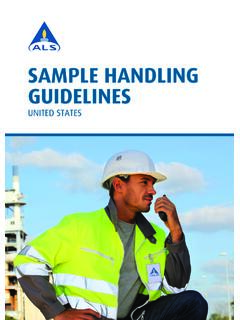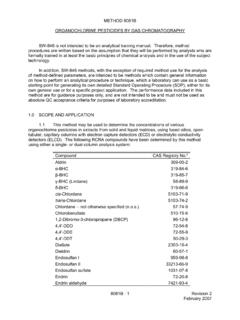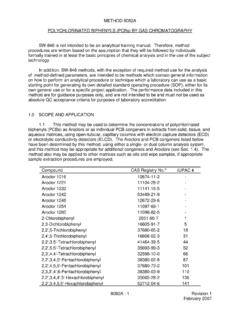Transcription of METHOD 8000D DETERMINATIVE CHROMATOGRAPHIC …
1 SW-846 Update VI 8000D - 1 Revision 5 March 2018 METHOD 8000D DETERMINATIVE CHROMATOGRAPHIC SEPARATIONS Table of Contents SCOPE AND APPLICATION .. 1 SUMMARY OF METHOD .. 6 DEFINITIONS .. 7 INTERFERENCES/ CHROMATOGRAPHIC PERFORMANCE .. 7 SAFETY .. 8 EQUIPMENT AND SUPPLIES .. 8 REAGENTS AND STANDARDS .. 12 SAMPLE COLLECTION, PRESERVATION, AND STORAGE .. 12 QUALITY 12 CALIBRATION AND STANDARDIZATION .. 25 PROCEDURE .. 26 DATA ANALYSIS AND CALCULATIONS .. 55 METHOD PERFORMANCE .. 55 POLLUTION PREVENTION .. 55 WASTE MANAGEMENT .. 55 REFERENCES .. 56 TABLES, DIAGRAMS, FLOWCHARTS, AND VALIDATION DATA .. 56 APPENDIX A .. 56 SW-846 is not intended to be an analytical training manual. Therefore, METHOD procedures are written based on the assumption that they will be performed by analysts who are formally trained in at least the basic principles of chemical analysis and in the use of the subject technology.
2 In addition, SW-846 methods in this manual, with the exception of required use for the analysis of METHOD -defined parameters, are intended to be guidance documents. They contain general information on how to perform an analytical procedure or technique, which a laboratory can use as a basic starting point for generating its own detailed standard operating procedure (SOP), either for its own general use or for a specific project application. Performance data included in this METHOD are for guidance purposes only and must not be used as absolute quality control (QC) acceptance criteria for the purpose of laboratory QC or accreditation. SCOPE AND APPLICATION Please see Appendix A at the back of this document for a summary of revisions to METHOD 8000C (From Revision 3, March 2003).
3 SW-846 Update VI 8000D - 2 Revision 5 March 2018 METHOD 8000 is not a DETERMINATIVE METHOD but instead provides guidance on analytical chromatography and describes calibration and QC requirements common to all SW-846 CHROMATOGRAPHIC methods . However, more specific QC requirements provided in the applicable DETERMINATIVE METHOD will supersede those noted in METHOD 8000. METHOD 8000 should be applied in conjunction with all SW-846 DETERMINATIVE CHROMATOGRAPHIC methods . The methods include, but are not limited to, the following: METHOD Number Analytes CHROMATOGRAPHIC Technique (Sec. ) Detector 6850 Perchlorate HPLC MS, MS/MS 6860 Perchlorate IC MS, MS/MS 7580 White phosphorus (P4) GC NICI/MS 8011 EDB, DBCP GC, capillary column ECD 8015 Non-halogenated volatiles GC, packed & capillary column FID 8021 Volatiles GC, capillary column PID, ELCD 8031 Acrylonitrile GC, packed column NPD 8032 Acrylamide GC, packed column ECD 8033 Acetonitrile GC, capillary column NPD 8041 Phenols Underivatized or derivatized.
4 GC, capillary column FID, ECD 8061 Phthalates GC, capillary column ECD 8070 Nitrosamines GC, packed column NPD, ELCD, TED 8081 organochlorine pesticides GC, capillary column ECD, ELCD 8082 Polychlorinated biphenyls GC, capillary column ECD, ELCD 8091 Nitroaromatics and cyclic ketones GC, capillary column ECD 8100 Polynuclear aromatic hydrocarbons GC, packed & capillary column FID 8111 Haloethers GC, capillary column ECD 8121 Chlorinated hydrocarbons GC, capillary column ECD 8131 Aniline and selected derivatives GC, capillary column NPD 8141 Organophosphorus pesticides GC, capillary column FPD, NPD, ELCD 8151 Acid herbicides Derivatized; GC, capillary column ECD 8260 Volatiles GC, capillary column MS 8261 Volatiles GC, capillary column MS 8265 Volatiles NA DS/ITMS 8270 Semivolatiles GC, capillary column MS 8275 Semivolatiles Thermal extraction/GC MS 8276 Toxaphene and Congeners GC, capillary column NICI/MS 8280 Dioxins and Dibenzofurans GC, capillary column Low resolution MS 8290 Dioxins and Dibenzofurans GC, capillary column High resolution MS 8310 Polynuclear aromatic hydrocarbons HPLC, reverse phase UV, Fluorescence SW-846 Update VI 8000D - 3 Revision 5 March 2018 METHOD Number Analytes CHROMATOGRAPHIC Technique (Sec.)
5 Detector 8315 Carbonyl compounds Derivatize; HPLC UV 8316 Acrylamide, acrylonitrile, acrolein HPLC, reverse phase UV 8318 N-Methyl carbamates Derivatize; HPLC Fluorescence 8321 Extractable non-volatiles PLC, reverse phase TS/MS, UV 8323 Organotin compounds HPLC, reverse phase ES/ITMS 8325 Extractable non-volatiles HPLC, reverse phase PB/MS, UV 8330 Nitroaromatics and nitramines HPLC, reverse phase UV 8331 Tetrazene HPLC, ion pair, reverse phase UV 8332 Nitroglycerine HPLC, reverse phase UV 8410 Semivolatiles GC, capillary column FT-IR 8430 Bis(2-chloroethyl) ether hydrolysis products GC, capillary column FT-IR DBCP = Dibromochloropropane DS/ITMS = Direct sampling/ion trap mass spectrometry ECD = Electron capture detector EDB = Ethylene dibromide ES/ITMS = Electrospray ionization/ion trap mass spectrometry ELCD = Electrolytic conductivity detector FID = Flame ionization detector FPD = Flame photometric detector FT-IR = Fourier transform-infrared GC = Gas chromatography HPLC = High performance liquid chromatography MS = Mass spectrometry MS/MS = Mass spectrometry/Mass spectrometry NICI/MS = Negative Ion Chemical Ionization/Mass spectrometry NPD = Nitrogen/phosphorous detector NA = Not applicable PAHs = Polynuclear aromatic hydrocarbons PB/MS = Particle beam mass spectrometry PID = Photoionization detector TED = Thermionic emission detector TS/MS = Thermospray
6 Mass spectrometry UV = Ultraviolet Analytical chromatography is used to separate target analytes from co-extracted interferences in samples. CHROMATOGRAPHIC methods can be divided into two major categories: GC and HPLC. GC is the separation technique of choice for organic compounds which can be volatilized without being decomposed or chemically rearranged. HPLC is a separation technique useful for semivolatile and non-volatile chemicals or for analytes that decompose upon heating. Successful liquid CHROMATOGRAPHIC separation requires that the analyte(s) of interest be soluble in the solvent(s) selected for use as the mobile phase. All CHROMATOGRAPHIC processes achieve separation by passing a mobile phase over a stationary phase. Constituents in a mixture are separated because they partition differently between the mobile and stationary phases and thus have different retention times.
7 Compounds that interact strongly with the stationary phase elute slowly ( , longer retention times), while compounds that remain in the mobile phase elute quickly ( , shorter retention times). The mobile phase for GC is an inert gas, usually hydrogen or helium, and the stationary phases are generally polymer bases. SW-846 Update VI 8000D - 4 Revision 5 March 2018 In "normal phase" HPLC, the mobile phase is less polar than the stationary phase. In "reverse phase" HPLC, the converse is true. Reverse phase HPLC is the technique of choice for environmental and waste analyses of non-volatile organic target analytes. Ion exchange chromatography is used to separate ionic species through competition with ions in the mobile phase for oppositely charged exchange sites on a stationary phase.
8 Differential selectivities of the ionic species and the mobile phase ions for exchange sites are responsible for the CHROMATOGRAPHIC separation of the ions. A number of specific GC and liquid chromatography (LC) techniques are used for environmental and waste analyses. Specific techniques are distinguished by the CHROMATOGRAPHIC hardware and chemical mechanisms used to achieve separations. GC methods , including those in SW-846, can be categorized on the basis of the CHROMATOGRAPHIC columns employed. HPLC methods in SW-846 are categorized on the basis of the mechanism of separation. SW-846 methods describe columns and conditions that have been demonstrated to provide optimum separation of all or most target analytes listed in that specific procedure. Most often, those columns were the ones used by EPA during METHOD development and testing.
9 Analysts may change those columns and conditions, provided that they demonstrate performance for the analytes of interest that is appropriate for the intended application. This is especially true when limited groups of analytes are to be monitored ( , if only a subset of the list of target analytes in a METHOD are needed, the CHROMATOGRAPHIC conditions and columns may be optimized for those analytes). CHROMATOGRAPHIC performance is demonstrated by the resolution of standards and the ability to model the response of the detector during calibration, and by sensitivity, precision, bias, frequency of false positives, and frequency of false negatives during analysis. The laboratory must demonstrate that any CHROMATOGRAPHIC procedure it uses provides performance satisfying the analytical requirements of the specific application for which it is being used.
10 Such demonstrations should be performed using the procedures outlined in Secs. to of this METHOD and appropriate sections in Chapter One. Laboratories must also be cautious whenever the use of two dissimilar columns is included in a METHOD for confirmation of identification and quantitation. For instance, a DB-5 column generally cannot be used for confirmation of results obtained using an SPB-5 column because the stationary phases are not sufficiently dissimilar and the changes in elution order (if any) will not provide adequate confirmation. When GC conditions are changed, retention times and analytical separations are often affected. For example, increasing the oven temperature changes the rate of partitioning between the mobile and stationary phases, leading to shorter retention times.












